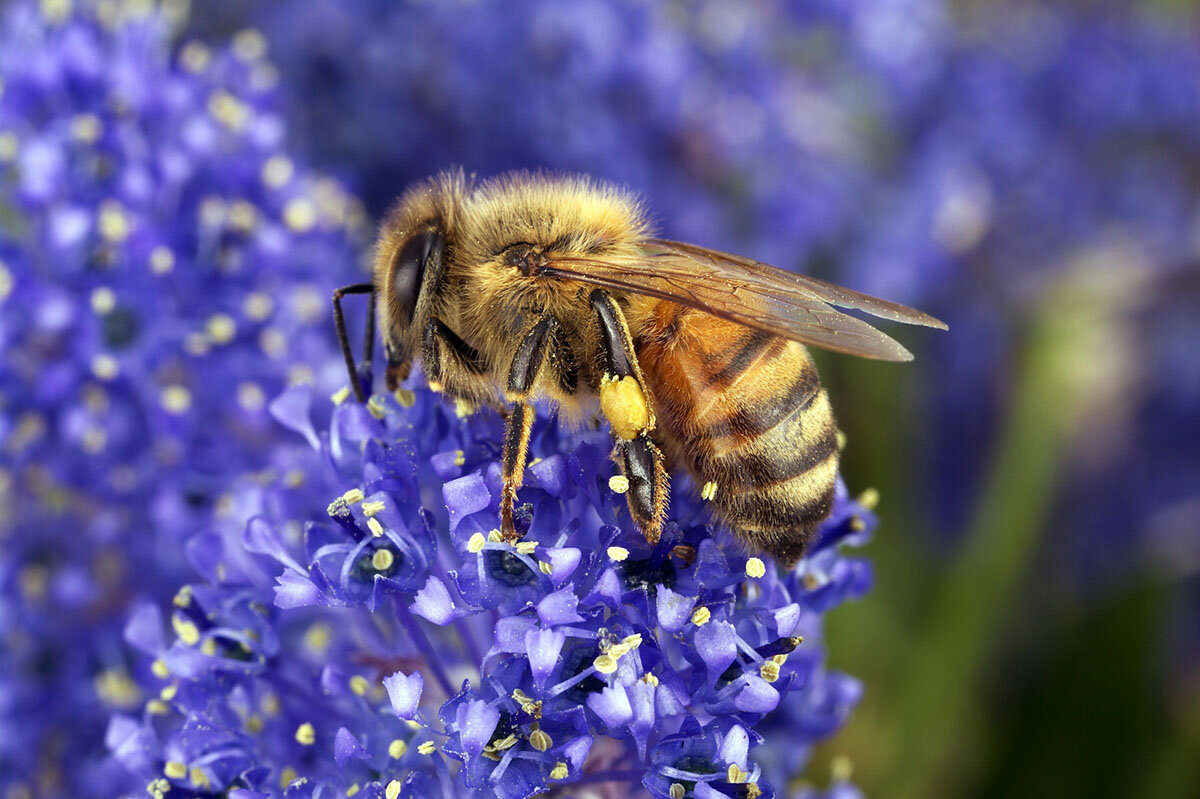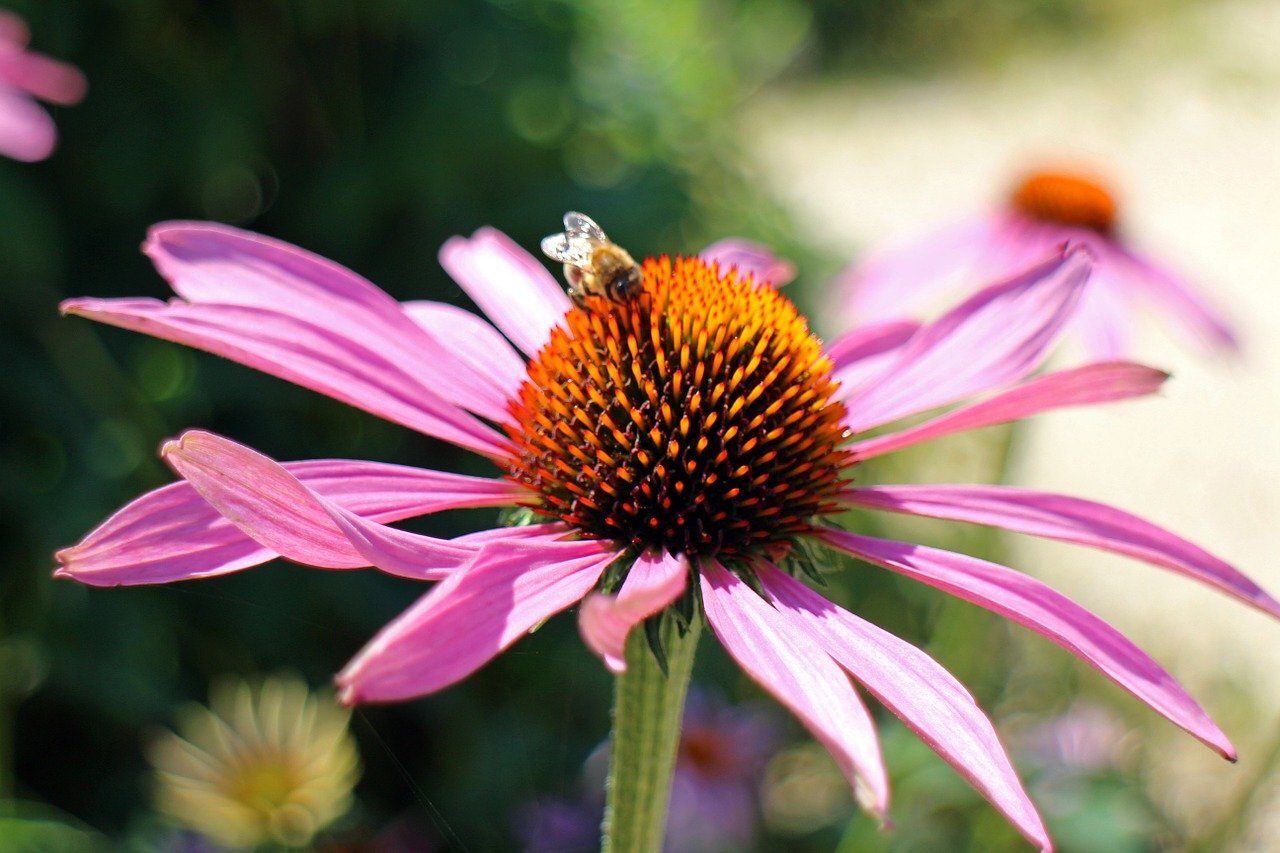Art Bee Sucking From Waterater Color Painting Flower and Bee
But like humans, healthy bees crave a counterbalanced diet. Yous may think bees take better access to food on farms than in the city but the truth is, bees that alive in urban areas yield more dear than those in rural environments!
Why? Because many farms are monocultures: giant fields of one plant. On the other hand, cities have a larger multifariousness of flowers.
If you want to support honeybees, creating a wildflower-rich garden with plenty for them to consume is one of the well-nigh impactful things you lot can practice. In this article, we go through seven plants you tin grow to support honeybees.
What exercise bees use pollen and nectar for?
When you come across a bee on a flower, it's not because it's actively trying to pollinate the constitute. That'due south simply a happy accident. What's actually happening is that the bee—and its colony—are hungry!
Bees utilise pollen and nectar equally food. Nectar provides them with carbohydrates, and pollen is their source of protein and fatty.
Honeybees stuff pollen into baskets on their legs and use their tongues to suck up nectar. Think of this as them collecting raw ingredients. Dorsum at the hive, the pollen and nectar are put into cells where it will be processed into honey and a substance called "bee bread" which they feed to their immature.

Await, only what about native pollinators?
Around 35% of crops rely to some extent on bees. That said, they're far from being the but pollinators we should care well-nigh. In North Carolina alone, at that place are over 500 species of native bees. And that number doesn't include other beneficial insects like collywobbles and moths!
When you plant a garden full of native flowers, you aid both honeybees and native pollinators. The more forage that'south bachelor, the less these species take to compete.
The 7 best flowers to plant for bees
You wouldn't desire your favorite grocery store to but be open for one month of the twelvemonth. In the same style, a good pollinator garden has flowers that bloom throughout the seasons. Some in spring, others in summer and fall.
Please annotation that our home state is North Carolina. In this guide, we selected plants that are native to our area, equally they're easier to maintain and provide provender for both honeybees and native pollinators.
If you're in a dissimilar state, we encourage you to seek out other guides. The Xerces Society for Invertebrate Conservation has a helpful resource center that'due south organized by location.

one. Bee lotion (Monarda spp.)
This plant is chosen "bee balm" because it was once used to treat bee stings, but bees really are obsessed with the flowers. There are a variety of plants in the bee balm family unit that are native to Due north Carolina. Most are aromatic and accept flowers that blossom for up to eight weeks.
Life Cycle: Perennial, biennial
Flavor: Spring
Calorie-free Requirement: Full sun, office sun
Soil Moisture: Dry, moist
Pack of 85 on Amazon for $6.99
two. White wild indigo (Baptisia alba)

White wild indigo grows two to 4 feet tall and tin can tolerate clay, gravel, and poor soil. This establish thrives with sun and occasional watering just tin can handle seasonal droughts or flooding. Afterwards the winter, it volition go dormant until the post-obit spring. In addition to bees, white wild indigo attracts frosted elfin butterflies and the block-spotted prominent moth. If you can't find white wild indigo in particular, any wild indigo volition do.
Life Cycle: Perennial
Season: Spring
Light Requirement: Total sun, part sun
Soil Moisture: Dry, Moist
Pack of 150 on Amazon for $3.25

3. Purple coneflower (Echinacea purpurea)
This beautiful perennial attracts honeybees, hummingbirds, and butterflies! It can be bought as a seedling at most garden stores. Be certain to water them until they become established. This plant can grow between two to 5 feet tall if you lot avert planting information technology near other plants. (Competition for soil nutrients doesn't permit it reach its full potential.) Imperial coneflower requires moisture and doesn't practice well in dry conditions.
Life Wheel: Perennial
Season: Late spring, summer
Low-cal Requirement: Full sunday, part lord's day
Soil Moisture: Moist
Pack of 100 on Amazon for $5.95
4. Black-eyed susan (Rudbeckia hirta)

For those of you nonetheless getting a hang of maintaining a garden, black-eyed susan requires very piffling care. It does okay in dry out soil and mature plants are able to tolerate dirt, rocky soil, heat, and drought. Just like the other plants on this list, it's a great source of nectar for other native pollinators including the bordered patch butterfly.

v. Joe-pye weed (Eutrochium purpureum)
As we motion into the autumn, bees need a source of nectar that lasts late into the season. That's where joe-pye weed comes in. It'south extremely aromatic, meaning it'll concenter bees and plenty of other pollinators including hummingbird moths.
Life Cycle: Perennial
Season: Fall
Light Requirement: Full lord's day, role sun
Soil Moisture: Dry, moist
Pack of 120 on Amazon for $three.99

half-dozen. Marsh blazing star (Liatris spicata)
This striking native institute can take a few years to grow from seeds, simply their eye-catching advent is worth the look. If this idea of starting from a seed intimidates you, there are a few online shops that sell the bulbs.
Life Cycle: Perennial
Season: Summertime
Lite Requirement: Full sunday
Soil Wet: Moist
10 live bulbs on Amazon for $39

seven. Wrinkleleaf goldenrod (Solidago rugosa)
Similar to black-eyed susan, wrinkleleaf goldenrod is very hardy. It can thrive even in poor, dry soils. People often blame goldenrod for causing hay fever (aka seasonal allergies) only they're mistaking it for ragweed which blooms at the same time.
Life Bicycle: Perennial
Flavour: Late summer, fall
Light Requirement: Full sun, role sun
Soil Wet: Dry out, moist
Where tin I buy these plants?
We added links to purchase the seeds on Amazon. Some of our recommendations, such as coneflowers, tin can exist found at most garden centers. (Yep, even Lowes or Home Carry.) For the harder-to-find flowers, check out this listing of plant supplies of the Chatham Mills Pollinator Paradise Demonstration Garden.
Do I have to grow native plants?
We favored native plants and perennials in this commodity. Even so, these can often be a niggling harder to detect at traditional retailers. Don't let this stop you lot from creating a garden. There are plenty of other easy-to-discover plants that honeybees like: mint, lavender, basil, to name a few. The important thing is to become started and have fun! Any size garden helps.
Farther resources
Even if you don't have space for a beehive, planting a few of the flowers above goes a long mode in helping bees
Congratulations on taking your get-go footstep toward creating a pollinator-friendly garden! It can experience overwhelming at starting time...there's a lot of information out there! We promise one time you get your first glimpse of a honeybee or butterfly drinking from a blossom that y'all planted you'll feel and so excited. .
Nosotros promise this short guide was helpful. If y'all'd similar more all-encompassing information here are some of our favorite resources:
-
Xceres Lodge Guide to Pollinator Plants for the Southeast Region
-
Comprehensive List of Plants at the "Pollinator Paradise" Garden at Chatham Mills
-
Video Garden Tour past NC Cooperative Extension
Source: https://www.buddhabeeapiary.com/blog/what-flowers-do-honeybees-like
0 Response to "Art Bee Sucking From Waterater Color Painting Flower and Bee"
Postar um comentário